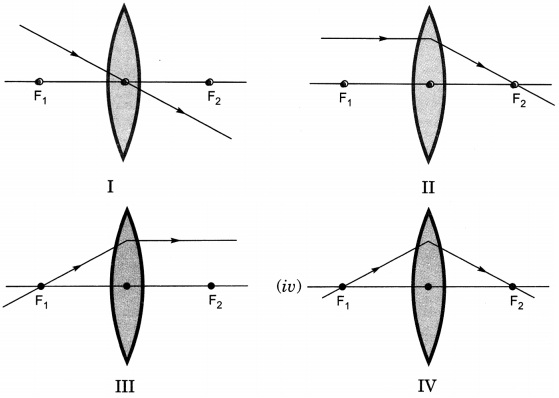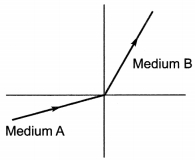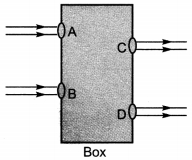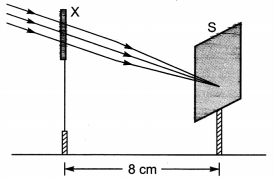MCQs for Class 10 Science Chapter 10 Light – Reflection and Refraction
MCQs for Class 10 Science Chapter 10 Light- Reflection and Refraction: In this article, we have covered all the important MCQs for Free for Class 10 Term 1 2021-22 Board Exams. In accordance with the latest pattern, Padhle is here with MCQ Questions for Class 10.
- Get MCQs for other Class 10 Chapters
- Get NCERT Solutions Class 10 Chapters
- Get Notes, PYQs, Free E-Books, and other material for Class 9
- Get Notes, PYQs, Free E-Books, and other material for Class 10
- Join our Telegram Channel for Latest Updates here
[adinserter block=”3″]
[twy_show_add_bookmark]
Class 10 for MCQ Science Chapter 10 Light- Reflection and Refraction
Question 1:
An object is placed 20 cm in front of a plane mirror. The mirror is moved 2 cm towards the object. The distance between the positions of the original and final images seen in the mirror is:
(a) 2 cm
(b) 4 cm
(c) 10 cm
(d) 22 cm
Answer: (a) 4 cm
Question 2:
Focal length of plane mirror is
(a) At infinity
(b) Zero
(c) Negative
(d) None of these
Answer: (a) At infinity
Question 3:
Which of the following can make a parallel beam of light when light from a point source is incident on it?
(a) Concave mirror as well as convex lens
(b) Convex mirror as well as concave lens
(c) Two plane mirrors placed at 90° to each other
(d) Concave mirror as well as concave lens
Answer: (a) Concave mirror as well as convex lens
Question 4:
In order to obtain a magnification of, -0.6 (minus 0.6) with a concave mirror, the object must be placed:
(a) At the focus
(b) Between pole and focus
(c) Between focus and center of curvature
(d) Beyond the center of curvature
Answer: (d) Beyond the center of curvature
Question 5:
A ray of light that strikes a plane mirror PQ at an angle of incidence of 30o, is reflected from the plane mirror and then strikes a second plane mirror QR placed at right angles to the first mirror. The angle of reflection at the second mirror is:
(a) 30o
(b) 45o
(c) 60o
(d) 90o
Answer: (c) 60o
Question 6:
Image formed by plane mirror is
(a) Real and erect
(b) Real and inverted
(c) Virtual and erect
(d) Virtual and inverted
Answer: (c) Virtual and erect
[adinserter block=”3″]
Question 7:
A 10 mm long awl pin is placed vertically in front of a concave mirror. A 5 mm long image of the awl pin is formed at 30 cm in front of the mirror. The focal length of this mirror is
(a) -30 cm
(b) -20 cm
(c) -40cm
(d) -60 cm
Answer: (b) -20 cm
Question 8:
A man runs towards the plane mirror at 2 m/s. The relative speed of his image with respect to him will be:
(a) 4 ms⁻¹
(b) 2 ms⁻¹
(c) 8 ms⁻¹
(d) 10 ms⁻¹
Answer: (a) 4 ms⁻¹
Question 9:
An object is placed at 100 mm in front of a concave mirror which produces an upright image (erect image). The radius of curvature of the mirror is:
(a) Less than 100 mm
(b) Between 100 mm and 200 mm
(c) Exactly 200 mm
(d) More than 200 mm
Answer: (d) More than 200 mm
Question 10:
A concave mirror gives real, inverted and same size image if the object is placed
(a) At F
(b) At infinity
(c) At C
(d) Beyond C
Answer: (c) At C
Question 11:
Under which of the following conditions a concave mirror can form an image larger than the actual object?
(a) When the object is kept at a distance equal to its radius of curvature
(b) When object is kept at a distance less than its focal length
(c) When object is placed between the focus and centre of curvature
(d) When object is kept at a distance greater than its radius of curvature
Answer: (c) When object is placed between the focus and centre of curvature
Question 12:
A concave lens form the image of an object which is :
(a) Virtual inverted and diminished
(b) Virtual upright and diminished
(c) Virtual inverted and enlarged
(d) Virtual upright and enlarged
Answer: (b) Virtual upright and diminished
[adinserter block=”3″]
Question 13:
Which position of the object will produce a magnified virtual image, if a concave mirror of focal length 15 cm is being used?
(a) 10 cm
(b) 20 cm
(c) 30 cm
(d) 35 cm
Answer: (a) 10 cm
Question 14:
Power of the lens is -40, its focal length is
(a) 4m
(b) -40m
(c) -0.25m
(d) -25m
Answer: (c) -0.25m
Question 15:
The diagrams showing the correct path of the ray after passing through the

(a) II and III only
(b) I and II only
(c) I, II and III
(d) I, II and IV
Answer: (c) I, II and III
Question 16:
Which of the given is NOT paired correctly?
(a) Solar furnace-concave mirror
(b) Rear -view mirror-convex mirror
(c) Magnifying glass -convex lens
(d) None of these
Answer: (d) None of these
Question 17:
A concave mirror produces a magnification of +4. The object is placed:
(a) At the focus
(b) Between focus and centre of curvature
(c) Between focus and pole
(d) Beyond the centre of curvature
Answer: (c) Between focus and pole
Question 18:
A concave mirror gives virtual, refract and enlarged image of the object but image of smaller size than the size of the object is
(a) At infinity
(b) Between F and C
(c) Between P and F
(d) At E
Answer: (c) Between P and F
[adinserter block=”3″]
Question 19:
A light ray enters from medium A to medium B as shown in figure. The refractive index of medium B relative to A will be

(a) greater than unity
(b) less than unity
(c) equal to unity
(d) zero
Answer: (a) greater than unity
Question 20:
An object is approaching a plane mirror at 5 cm/s. A stationary observer sees the image. At what speed will the image appear to approach the stationary observer?
(a) 20 cm/s
(b) 10 cm/s
(c) 15 cm/s
(d) 5 cm/s
Answer: (b) 10 cm/s
Question 21:
Two big mirrors A and B are fitted side by side on a wall. A man is standing at such a distance from the wall that he can see the erect image of his face in both the mirrors. When the man starts walking towards the mirrors, he finds that the size of his face in mirror A goes on increasing but that in mirror B remains the same:
(a) Mirror A is concave and mirror B is convex
(b) Mirror A is plane and mirror B is concave
(c) Mirror A is concave and mirror B is plane
(d) Mirror A is convex and mirror B is concave
Answer: (c) Mirror A is concave and mirror B is plane
Question 22:
In optics an object which has higher refractive index is called
(a) Optically rarer
(b) Optically denser
(c) Optical density
(d) Refractive index
Answer: (b) Optically denser
Question 23:
Beams of light are incident through the holes A and B and emerge out of box through the holes C and D respectively as shown in the figure. Which of the following could be inside the box?

(a) A rectangular glass slab
(b) A convex lens
(c) A concave lens
(d) A prism
Answer: (a) A rectangular glass slab
Question 24:
Refractive index:
(a) Depends on the wavelength of light used to measure
(b) Is actual property of the substance
(c) Depends on the angle of incidence
(d) None of these
Answer: (a) Depends on the wavelength of light used to measure
[adinserter block=”3″]
Question 25:
A ray of light is travelling in a direction perpendicular to the boundary of a parallel glass slab. The ray of light:
(a) Is refracted towards the normal
(b) Is refracted away from the normal
(c) Is reflected along the same path
(d) Does not get refracted
Answer: (d) Does not get refracted
Question 26:
The optical phenomena, twinkling of stars, is due to
(a) Atmospheric reflection
(b) Total reflection
(c) Atmospheric refraction
(d) Total refraction
Answer: (c) Atmospheric refraction
Question 27:
Which of the following statements is true?
(a) A convex lens has 4 dioptre power having a focal length 0.25 m
(b) A convex lens has -4 dioptre power having a focal length 0.25 m
(c) A concave lens has 4 dioptre power having a focal length 0.25 m
(d) A concave lens has -4 dioptre power having a focal length 0.25 m.
Answer: (a) A convex lens has 4 dioptre power having a focal length 0.25 m
Question 28:
A hunter wants to shoot a fish whose image can be seen through clear water. It is to be aimed:
(a) Below the image of fish
(b) Above the image of fish
(c) Directly towards the image
(d) In any direction
Answer: (a) Below the image of fish
Question 29:
A ray of light passes from a medium X to another medium Y. No refraction of light occurs if the ray of light hits the boundary of medium Y at an angle of:
(a) 120o
(b) 90o
(c) 45o
(d) 0o
Answer: (b) 90o
Question 30:
Convex lens focus a real, point sized image at focus, the object is placed
(a) At focus
(b) Between F and 2F
(c) At infinity
(d) At 2F
Answer: (c) At infinity
[adinserter block=”3″]
Question 31:
Magnification produced by a rear view mirror fitted in vehicles
(a) is less than one
(b) is more than one
(c) is equal to one
(d) can be more than or less than one depending upon the position of the object in front of it.
Answer: (a) is less than one
Question 32:
On heating a liquid the refractive index generally:
(a) Increases
(b) Decreases
(c) Does not change
(d) Increases or decreases depending upon rate of heating
Answer: (b) Decreases
Question 33:
A lens of focal length 12 cm forms an erect image, three times the size of the object. The distance between the object and image is:
(a) 8 cm
(b) 16 cm
(c) 24 cm
(d) 36 cm
Answer: (b) 16 cm
Question 34:
The unit of power of lens is
(a) Meter
(b) Centimeter
(c) Diopter
(d) M-1
Answer: (c) Diopter
Question 35:
Rays from Sun converge at a point 15 cm in front of a concave mirror. Where should an object be placed so that size of its image is equal to the size of the object?
(a) 15 cm in front of the mirror
(b) 30 cm in front of the mirror
(c) between 15 cm and and 30 cm in front of the mirror
(d) more than 30 cm in front of the mirror
Answer: (b) 30 cm in front of the mirror
Question 36:
A lens has a power of +0.5D. It is:
(a) A concave lens of local length 5 m
(b) A convex lens of focal length 2 m
(c) A convex lens of focal length 5 m
(d) A concave lens of focal length 2 m
Answer: (b) A convex lens of focal length 2 m
[adinserter block=”3″]
Question 37:
If an object is placed 21 cm from a converging lens, the image formed is slightly smaller than the object. If the object is placed at a distance of 19 cm from the lens, the image formed is slightly larger than the object. The approximate focal length of the lens is:
(a) 20 cm
(b) 18 cm
(c) 10 cm
(d) 5 cm
Answer: (c) 10 cm
Question 38:
The radius of curvature of a mirror is 20cm the focal length is
(a) 20cm
(b) 10cm
(c) 40cm
(d) 5cm
Answer: (b) 10cm
Question 39:
A full length image of a distant tall building can definitely be seen by using
(a) a concave mirror
(b) a convex mirror
(c) a plane mirror
(d) both concave as well as plane mirror
Answer: (b) a convex mirror
Question 40:
In torches, search lights and headlights of vehicles the bulb is placed
(a) between the pole and the focus of the reflector
(b) very near to the focus of the reflector
(c) between the focus and centre of curvature of the reflector
(d) at the centre of curvature of the reflector
Answer: (b) very near to the focus of the reflector
Question 41:
In which of the given cases do we get very strong reflected rays and very weak refracted rays ?
(a) Light passing from air to glass
(b) Light passing from water to glass
(c) Light passing from glass to diamond
(d) Light passing from water to air
Answer: (d) Light passing from water to air
Question 42:
In order to increase the magnifying power of a microscope :
(a) The objective should have larger focal length and eyepiece should have small focal length
(b) The focal power of the objective and the eyepiece should be larger
(c) The objective should have small focal length and the eyepiece should have larger focal length
(d) The focal length of the objective and the eyepiece should be large
Answer: (a) The objective should have larger focal length and eyepiece should have small focal length
[adinserter block=”3″]
Question 43:
A student does the experiment on tracing the path of a ray of light passing through a rectangular glass slab for different angles of incidence. He can get a correct measure of the angle of incidence and the angle of emergence by following the labelling indicated in figure:

(a) A
(b) B
(c) C
(d) D
Answer: (d) D
Question 44:
A student traces the path of a ray of light passing through a rectangular slab for three different values of angle of incidence (∠i ) namely 30o, 45o and 60o. He extends the direction of incident ray by a dotted line and measures the perpendicular distance ‘l’ between the extended incident ray and the emergent ray.

He will observe that:
(a) ‘l’ keeps on increasing with increase in angle of incidence
(b) ‘l’ keeps on decreasing with increase in angle of incidence
(c) ‘l’ remains the same for all three angles of incidence
(d) ‘l’ is the maximum for ∠i = 45o and is less than this value for ∠i = 30o and ∠i = 60o.
Answer: (a) ‘l’ keeps on increasing with increase in angle of incidence
Question 45:
The image which is formed behind the mirror
(a) real image
(b) virtual image
(c) blue image
(d) partial image
Answer: (b) virtual image
Question 46:
Convex lens is also known as
(a) converging lens
(b) diverging lens
(c) radial lens
(d) axial lens
Answer: (a) converging lens
Question 47:
Using a convex lens, a clear image of candle flame is produced on a screen. How many other clear images can be received on this screen if only the lens is to be shifted ?
(a) A large number
(b) Only one more
(c) Two more
(d) None of these
Answer: (b) Only one more
Question 48:
A parallel beam of light is incident on a converging lens parallel to its principal axis. As we move away from the lens on the other side on its principal axis the intensity of light
(a) Remains constant
(b) Continuously increases
(c) Continuously decreases
(d) First increases and then decreases
Answer: (d) First increases and then decreases
[adinserter block=”3″]
Question 49:
Four students A, B, C and D performed the experiment to determine the focal length of a concave mirror by obtaining the image of a distant tree on a screen. They measured the distances between the screen and the mirror as shown in the diagrams given below:

The correct way to measure accurate focal length of the mirror is:
(a) A
(b) B
(c) C
(d) D
Answer: (c) C
Question 50:
A student traces the path of a ray of light passing through a rectangular slab.

For measuring the angle of incidence, he must position the protractor in the manner shown in the figure:
(a) A
(b) B
(c) C
(d) D
Answer: (d) D
Question 51:
While performing an experiment on determination of focal length of a convex lens, four students obtained the image of the same distant tree on the screen as follows:

Which diagram shows the formation of image correctly?
(a) A
(b) B
(c) C
(d) D
Answer: (d) D
Question 52:
The deviation of light ray from its path when it travels from one transparent medium to another transparent medium is called
(a) reflection
(b) refraction
(c) dispersion
(d) scattering
Answer: (b) refraction
Question 53:
The laws of reflection hold good for
(a) plane mirror only
(b) concave mirror only
(c) convex mirror only
(d) all mirrors irrespective of their shape
Answer: (d) all mirrors irrespective of their shape
Question 54
The mirror used as rear-view mirror in vehicles
(a) convex mirror
(b) plane mirror
(c) cylindrical mirror
(d) concave mirror
Answer: (a) convex mirror
[adinserter block=”3″]
Question 55:
You are given water, mustard oil, glycerine and kerosene. In which of these media a ray of light incident obliquely at same angle would bend the most?
(a) Kerosene
(b) Water
(c) Mustard oil
(d) Glycerin
Answer: (d) Glycerin
Question 56:
When white light moves through vacuum :
(a) Violet has greater speed than red
(b) Red has greater speed than violet
(c) All colors have the same speed
(d) Different colors have different random speeds
Answer: (c) All colors have the same speed
Question 57:
Magnifying power of a compound microscope is the ratio of the angle formed by the final image to the angle formed by the object when :
(a) Image is at the least distance of distinct vision and object may be anywhere
(b) Object and image are both at infinity
(c) Object and image are both at the least distance of distinct vision
(d) Object is placed at the least distance of distinct vision and image may be at any place
Answer: (d) Object is placed at the least distance of distinct vision and image may be at any place
Question 58:
Spherical air bubble in water will act as :
(a) A concave lens
(b) A convex lens
(c) Plane-concave lens
(d) Plane glass plate
Answer: (a) A concave lens
[adinserter block=”3″]
Question 59:
A child is standing in front of a magic mirror. She finds the image of her head bigger, the middle portion of her body of the same size and that of the legs smaller. The following is the order of combinations for the magic mirror from the top.
(a) Plane, convex and concave
(b) Convex, concave and plane
(c) Concave, plane and convex
(d) Convex, plane and concave
Answer: (c) Concave, plane and convex
Question 60:
A student used a device (X) to obtain/focus the image of a well illuminated distant building on a screen (S) as shown alongside in the diagram. Select the correct statement about the device (X).

(a) This device is a concave lens of focal length 8 cm.
(b) This device is a convex mirror of focal length 8 cm.
(c) This device is a convex lens of focal length 4 cm.
(d) This device is a convex lens of focal length 8 cm.
Answer: (d) This device is a convex lens of focal length 8 cm.
Click Here to Download the PDF of MCQs for this Chapter
For More Content related to Class 10 –
- Get MCQs for other Class 10 Chapters
- Get NCERT Solutions Class 10 Chapters
- Get Notes, PYQs, Free E-Books, and other material for Class 9
- Get Notes, PYQs, Free E-Books, and other material for Class 10
- Join our Telegram Channel for Latest Updates here
[adinserter block=”3″]










